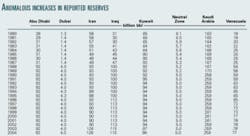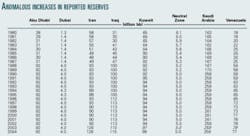Comment: Just how much oil does the Middle East really have, and does it matter?
Just a few months ago, oil economists were debating if the Organization of Petroleum Exporting Countries had the power to hold oil prices in the mid-$20/bbl range. There was talk of the increasing demands for oil from China's new economic prosperity, but generally the age-old perception that supply must always equal demand in a properly functioning open market remained in tact.
Admittedly, it was recognized that production in North America was in relentless decline, meaning that the need for growing imports was not about to abate. The growing dependence on oil from the Middle East did give rise to some concerns, with the countries in that region being commonly depicted as "politically unstable."
Some observers concluded that there must have been an oil agenda behind the invasion of Iraq, as seemed to be vindicated when the weapons of mass destruction, which had been presented as the justification for war, turned out to be nonexistent.
Those days have passed as the world comes to terms with oil prices around double the previous level. Indeed, $50/bbl is almost being seen more as a floor than a ceiling.
If it were simply a matter of taking control of the Middle East by diplomacy or in other ways, oil prices might return to traditional levels and allow the US to import its needs, but what if the Middle East turns out to have less oil than commonly imagined?
The reserves of oil in these countries are effectively state secrets, so it is impossible to check proved reserves, as presented in normal stock exchange reports.
There are several industry databases, but they can do little more than report the official information since they are not themselves in a position to evaluate the geological or engineering parameters in detail.
Historical references
At the end of the day, perhaps history offers the best hope of making a realistic estimate of what this ever-so-critical region may hold.
Looking at earlier issues of Oil & Gas Journal, we find that Kuwait reported reserves of 65 billion bbl in 1980. It had produced 20.28 billion bbl to that point in time, meaning that a total of about 85 billion bbl had been found. Much of it lay in the well-known Burgan field, discovered in 1938, but there were also a number of other fields of giant size.
By 1984, Kuwait's cumulative oil production had risen to 21.53 billion bbl, which explains why reported reserves had fallen to 64 billion bbl, given there had been no significant discoveries in the meantime.
However in 1985, Kuwait announced a massive increase of reserves—to 90 billion bbl—which was clearly implausible in relation to the long sequence of earlier reports, but it was close to the total discovered, assuming a slightly more generous recovery factor.
It has been suggested that one of the reasons for this sudden increase was a new OPEC procedure whereby production quotas were partly based on reported reserves.
Iraq was certainly displeased by Kuwait's action and instituted legal proceedings for the consequential loss of revenue, but the other OPEC member countries took no particular immediate action.
In 1987, Kuwait added another 2 billion bbl, bringing its total reported reserves to 92 billion bbl, which seems to have over-stretched the tolerance of its neighbors, who were now forced to react.
A simple solution was to report roughly the same number as Kuwait.
Accordingly, in 1988, Abu Dhabi came in with precisely the same 92 billion bbl in reserves as reported by Kuwait, up from the 31 billion bbl reported in the preceding year; Iran went one better reporting 93 billion bbl, up from 49 billion bbl; while Iraq, not to be outdone, came in with a rounded 100 billion bbl, up from 47 billion bbl.
But Saudi Arabia faced a difficulty not being able to match Kuwait since it was already reporting more. It pondered its decision for 2 more years before announcing a massive increase from 170 billion bbl to 258 billion bbl, presumably having decided to follow the precedent of Kuwait in reporting total discovered (also described as "original reserves"), and not remaining reserves.
It is noteworthy that the Neutral Zone, which is shared by Kuwait and Saudi Arabia, announced no such increase, presumably because its two owners had no common motive for doing so.
Venezuela on the other side of the world was obliged to match these events in the Middle East, increasing its reported reserves to 56 billion bbl from 25 billion bbl in 1988, justifying the move by the inclusion of nonconventional oil, not hitherto counted.
The foregoing explains why the reported reserves of these countries have barely changed since, despite substantial production.
Such additions as have been reported may reflect genuine new discoveries or improved recovery assumptions.
The Age of Oil
The total current reported reserves of these five Middle East countries is 696 billion bbl, and production to date is 255 billion bbl (including Neutral Zone and war loss in Kuwait).
But if the 696 billion bbl represents total discovered reserves as the foregoing argument suggests, it means that the real reserves are only 441 billion bbl.
OGJ estimates world reserves for 2004 at 1,278 billion bbl. If we remove the Middle East anomaly discussed above and the 170 billion bbl that were added in respect to Canadian oil sands in 2003, we arrive at a new, more realistic world total of 853 billion bbl.
Some 65 published estimates of the ultimate recovery of conventional oil—many by major oil companies and legitimate government institutions—give an average of 1,930 billion bbl.
The world has so far produced 944 billion bbl, and realistic reserves on the above basis stand at 853 billion bbl, meaning that there are 133 billion bbl yet-to-find if we accept the ultimate estimate.
New discoveries, especially of critical giant fields, have been falling for 40 years, as confirmed by ExxonMobil Corp. being down to less than 10 billion in reserves last year. It suggests that this calculation is not altogether unreasonable.
It sounds as if the world has used about 49% of its endowment of conventional oil, meaning that it is now close to the midpoint of depletion, which normally corresponds with peak production. Peak itself is not a particular significant event but the relentless downward slope that follows it most certainly is.
We can say, in other words, that the world has reached the end of the First Half of the Age of Oil, which lasted 150 years since the first wells were drilled in Pennsylvania and on the shores of the Caspian Sea.
It saw the rapid expansion of industry, transport, trade, agriculture, and financial capital, much made possible by the abundant supply of cheap and convenient oil-based energy. The world population expanded six-fold—exactly in parallel with oil.
Now, the Second Half of the Age of Oil dawns. It will be marked by the decline of oil production, and all that depends on it. The transition is likely to be a time of great tension and difficulty, particularly in respect to financial capital.
Capital was generated during the First Half of the Oil Age on the confidence that tomorrow's expansion provided collateral for today's debt.
It follows that the system will fail during the Second Half if the decline of oil undermines the scope for expansion.
It sounds like a serious topic, underlining the need for greater transparency in reserves reporting. The emphasis is on the word reporting, for engineers can now make good estimates of the size of an oil field early its life, especially with the help of all the remarkable advances in technology and knowledge.
But serious topics are not often popular ones, which explains why many people, including those in government, may prefer not to know.
The author
Colin J. Campbell has more than 40 years' experience in the oil industry. After receiving his PhD in geology from Oxford in 1957, he worked as exploration geologist for Texaco Inc. Since then, he has worked for BP Group LLC and Amoco Production Co. as Amoco's regional geologist for Latin America and later chief geologist for Amoco Ecuador. He was general manager for Shenandoah Oil Corp. in Britain responsible for creating new ventures in the North Sea, Ireland, Portugal, Turkey, and the Netherlands, then rejoined Amoco in London in 1979 and was appointed exploration manager in Norway the following year. During 1984-89, he was executive vice-president of Fina Oil & Chemical Co. in Norway. In retirement, Campbell serves as consultant to governments and major oil companies and is a trustee of the Oil Depletion Analysis Center, London. He has authored two books and numerous papers. In 2001, he founded the Association for the Study of Peak Oil and Gas, of which he is honorary chairman. Campbell is a member of the American Association of Petroleum Geologists; the Geological Society, London; and the Institute of Petroleum, London.


